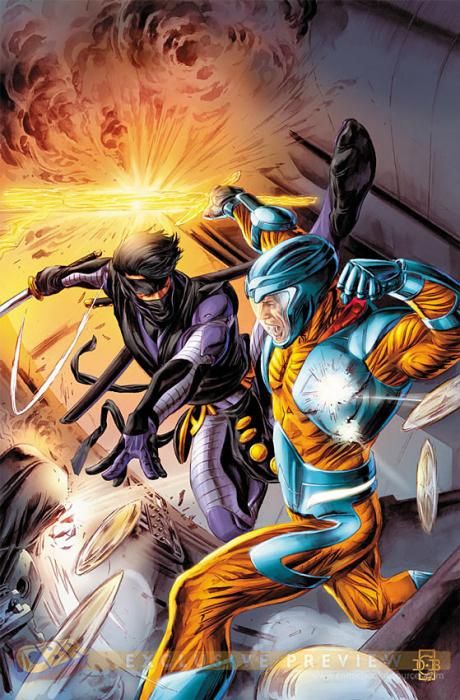In "X-O Manowar" #6, Ninjak and Aric have a rematch when Aric awakens and is assisted by an unlikely ally, and writer Robert Venditti's script has excellent suspense and pacing. A third of the issue contains fight scenes, but Lee Garbett's pencils for action sequences are so strong that they convey both character development and the excitement of martial conflict.
Garbett's pencils have stronger body language than facial expressions, to interesting effect. While the characters' facial expressions are fine to convey basic reactions to events, they're nothing extraordinary, and Ninjak and X-O Manowar's costumes cover so much of their faces. Garbett's use of body language is far more expressive. In a quiet moment in "X-O Manowar" #6, Alexander Dorian's hunched shoulders and clenched hands perfectly convey his anxiety.
Even more impressively, there's ample body language in the fight scenes. Aric has bull-like, muscular tension in his neck and fists, and he's consistently emotional in battle. In contrast, Ninjak's movements carry a tone of cold, strategic efficiency and surly darkness, and he is graced with elegant, precise movements, like a surgeon wielding another type of blade. In combat, Ninjak also uses settings to his strategic advantage, as if he was playing pool and everything was a matter of math. Venditti has Ninjak compare himself to a scalpel, and even better, Garbett has drawn it. Combat scenes in comics often don't differentiate between offensive approaches and fighting styles. Garbett's attention in this area is an aesthetic pleasure by itself, both for the martial as well as visual arts, and it's also perfectly dovetails with Venditti's characterization.
A panel with Ninjak running across a rooftop feels like classic camera shot, but it's charged with movement and anticipation. The body is balanced and realistic, and it's pleasing to see that when an artist knows his anatomy and foreshortening, he doesn't need to use action lines to convey speed or to make a fight scene more exciting. This lack of visual clutter also strengthens Garbett's compositions. A skinny panel with Ninjak and two parachutes dropping from a plane is lovely in its balance and simplicity.
In his tussles with Ninjak so far, Aric's only advantage is his Shanhara armor. In "X-O Manowar" #6, Aric comes close to being overshadowed in his own book. While Aric's stiff, Conan-esque dialogue emphasizes his time-lost-traveler angst and backstory, it also widens the distance between him and reader a little. Ninjak has better lines, better brains and more wit. It's tempting to agree with Ninjak's assessment on the first page, "He's bigger than the dummies I practice on. About as smart, too." It's a subversive move by Venditti to give the lesser fighter the bigger muscles, and even more subversive to have the main character be outmaneuvered so early in his own title.
Despite these nitpicks about archetypes and borrowed martial arts finery, Venditti's take on the character steals the spotlight of every page he appears in "X-O Manowar" #6. Ninjak was massively popular back in Valiant's original heyday, and his particular mix of action hero traits -- intelligence, use of technology, coolness under pressure and brutal professionalism -- still has potency.
Vine plant Alexander Dorian becomes more of a major player in "X-O Manowar" #6, although his choices and motivations aren't completely explicable yet. My hope is that with ambiguous, engaging characters like Alexander Dorian, Ninjak and Aric himself, Venditti will continue to make the good vs. evil question in this book less simplistic, or dodge it entirely, while continuing to deliver a strong espionage action book with fantasy and science fiction elements.

